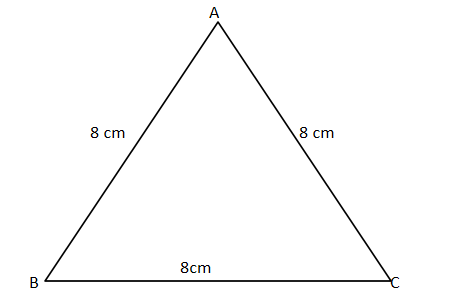
The area of the equilateral triangle whose side is $8{\text{cm}}$, is:
A. $64{\text{c}}{{\text{m}}^2}$
B. ${\text{16}}\sqrt 3 {\text{c}}{{\text{m}}^2}$
C. ${\text{21}}{\text{.3c}}{{\text{m}}^2}$
D. $4\sqrt 3 {\text{c}}{{\text{m}}^2}$
Answer
557.7k+ views
Hint: Here we are given the side of the equilateral triangle. Equilateral triangle is the triangle with all sides equal which is given to be $8{\text{cm}}$. So we will use the formula of the area of the equilateral triangle which is:
${\text{Area(A)}} = \dfrac{{\sqrt 3 }}{4}{a^2}$
Here $a$ is the length of each side and ${\text{A}}$ is the area.
Complete step-by-step answer:
Here we are given the side of the equilateral triangle and we need to find the area of it. Here we must have the knowledge of what an equilateral triangle is. It is the triangle in which all the three sides are equal in length which is given here as $8{\text{cm}}$
Here we have the equilateral triangle with the side $8{\text{cm}}$

Here we have all three sides equal to $8{\text{cm}}$ and we must know what the formula to calculate the area of the equilateral triangle is.
${\text{Area(A)}} = \dfrac{{\sqrt 3 }}{4}{a^2}$
Here $a$ is the length of each side and ${\text{A}}$ is the area.
So we can say here that $a = 8{\text{cm}}$
Bow substituting the value of $a = 8$ in the given formula of the area of the equilateral triangle we get that:
$\Rightarrow$ ${\text{Area(A)}} = \dfrac{{\sqrt 3 }}{4}{a^2}$
$\Rightarrow$ ${\text{A}} = \dfrac{{\sqrt 3 }}{4}{(8)^2}$
$\Rightarrow$ ${\text{A}} = \dfrac{{\sqrt 3 }}{4} \times 64 = 16\sqrt 3 $
So here we get the value of the area as $16\sqrt 3 $ and its units according to the formula will be:
We have taken the square of the side in the formula, so we will have the unit of area as the square of the unit of the side which is given as ${\text{centimetre}} = {\text{cm}}$
So we have area of the triangle as ${\text{A}} = \dfrac{{\sqrt 3 }}{4} \times 64 = 16\sqrt 3 {\text{c}}{{\text{m}}^2}$
So option B is correct.
Note: Here we must know that this formula of area is only valid when all the three sides of the triangle are equal which means that it is only valid for the equilateral triangle. If we have the triangle whose all sides are unequal then we can use Heron’s formula which is given as
${\text{A}} = \sqrt {s(s - a)(s - b)(s - c)} $
Here $s$ represents the semi-perimeter of the triangle which means half of the total perimeter and $a,b,c$ are the three sides of the triangle.
So $s = \dfrac{{a + b + c}}{2}$
${\text{Area(A)}} = \dfrac{{\sqrt 3 }}{4}{a^2}$
Here $a$ is the length of each side and ${\text{A}}$ is the area.
Complete step-by-step answer:
Here we are given the side of the equilateral triangle and we need to find the area of it. Here we must have the knowledge of what an equilateral triangle is. It is the triangle in which all the three sides are equal in length which is given here as $8{\text{cm}}$
Here we have the equilateral triangle with the side $8{\text{cm}}$

Here we have all three sides equal to $8{\text{cm}}$ and we must know what the formula to calculate the area of the equilateral triangle is.
${\text{Area(A)}} = \dfrac{{\sqrt 3 }}{4}{a^2}$
Here $a$ is the length of each side and ${\text{A}}$ is the area.
So we can say here that $a = 8{\text{cm}}$
Bow substituting the value of $a = 8$ in the given formula of the area of the equilateral triangle we get that:
$\Rightarrow$ ${\text{Area(A)}} = \dfrac{{\sqrt 3 }}{4}{a^2}$
$\Rightarrow$ ${\text{A}} = \dfrac{{\sqrt 3 }}{4}{(8)^2}$
$\Rightarrow$ ${\text{A}} = \dfrac{{\sqrt 3 }}{4} \times 64 = 16\sqrt 3 $
So here we get the value of the area as $16\sqrt 3 $ and its units according to the formula will be:
We have taken the square of the side in the formula, so we will have the unit of area as the square of the unit of the side which is given as ${\text{centimetre}} = {\text{cm}}$
So we have area of the triangle as ${\text{A}} = \dfrac{{\sqrt 3 }}{4} \times 64 = 16\sqrt 3 {\text{c}}{{\text{m}}^2}$
So option B is correct.
Note: Here we must know that this formula of area is only valid when all the three sides of the triangle are equal which means that it is only valid for the equilateral triangle. If we have the triangle whose all sides are unequal then we can use Heron’s formula which is given as
${\text{A}} = \sqrt {s(s - a)(s - b)(s - c)} $
Here $s$ represents the semi-perimeter of the triangle which means half of the total perimeter and $a,b,c$ are the three sides of the triangle.
So $s = \dfrac{{a + b + c}}{2}$
Recently Updated Pages
Master Class 8 Maths: Engaging Questions & Answers for Success

Class 8 Question and Answer - Your Ultimate Solutions Guide

Master Class 12 Economics: Engaging Questions & Answers for Success

Master Class 12 Maths: Engaging Questions & Answers for Success

Master Class 12 Biology: Engaging Questions & Answers for Success

Master Class 12 Physics: Engaging Questions & Answers for Success

Trending doubts
Which one of the following groups comprises states class 8 social science CBSE

A couple went for a picnic They have 5 sons and each class 8 maths CBSE

Advantages and disadvantages of science

Write a letter to the Municipal Commissioner to inform class 8 english CBSE

What are the methods of reducing friction. Explain

Differentiate between the farms in India and the U class 8 social science CBSE





